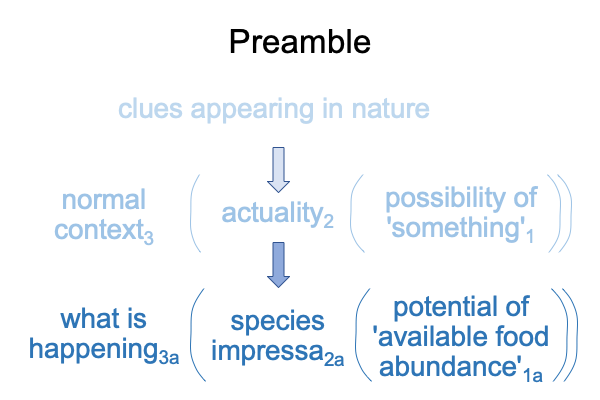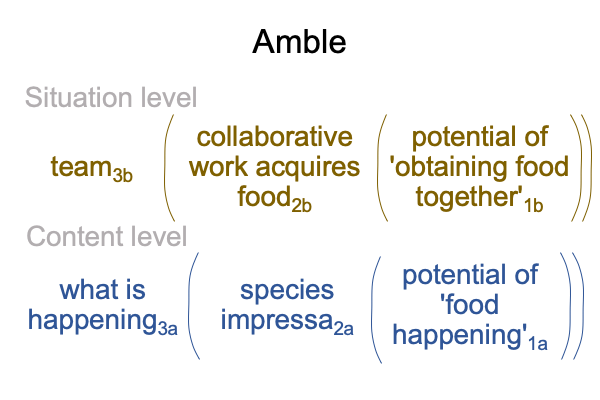0029 What is happening3a? What does it mean to me3b?
These questions define sensible thought.
One can say that the mental operations signified by the scholastic interscope for the way humans sensibly think must be typical of the species, that is, phenotypic. One can also say that this sensible construction is cultural, since the actions of the adult cultivates the mind of the youngster.
0030 I can ask, “How many types of these habitual events are there?”
Well, as many as there are ways to eat.
For tropical forest, individual foraging does the trick.
For mixed forest and savannah, the southern apes must have had a few more challenges. Locations with lots of foodchange with the seasons and with the weather. Plus, each plentiful location has more food than any one can eat on the spot. So, the hominins rely on one another to remember all these details of location and season and other pertinent information. They do so by forming teams. One lucky team (of 15 cooperators) can gather enough food for an entire band (of 50 members).
0031 If a particular sensible construction (coupling a food event2a with a perception2b) occurs often enough, then could it support sociogenesis, in the style of seasonal (and occasionally permanent) teams?
The answer is obviously, “Yes.”
0032 But, how are teams (15) different than friends (5) and the band (50)?
Tomasello hones in on the idea of joint attention. The process starts with natural clues that a certain food is available to a team, which is already prepared for obtaining and processing that food, when it is available. This serves as a preamble to what happens next.

0033 Clearly, triadic relations, such as the category-based nested form and sign-processing are in play. Each member of a team has similar impressions2a. A team3b spontaneously assembles. If the use of twigs by chimpanzees to fish for termites is cultural, then assembled teams are cultural units. Each team-member remembers this or that. Each offers a style of operation for others to imitate. Plus, the assembled team engages in what Tomasello calls, “joint attention”.
Sensible construction serves as the amble, or “walk” in Old English. Remember that southern apes are bipedal.

0034 Once the team is engaged, the preamble changes slightly.

The amble changes accordingly.

0035 The circuit of preamble and amble continues until the job is complete.
Chapter three, titled “Joint Attention and Cultural Learning”, paints a picture similar to these diagrams, but without the triadic relations.
0036 Plus, Tomasello dwells on the behavior of newborns and infants, noting how their attention fixes on objects (species impressa2a) as well as other persons and self (team3b).
Indeed, if any infant could talk, he or she would say that the most important team in the world is mom and me.
